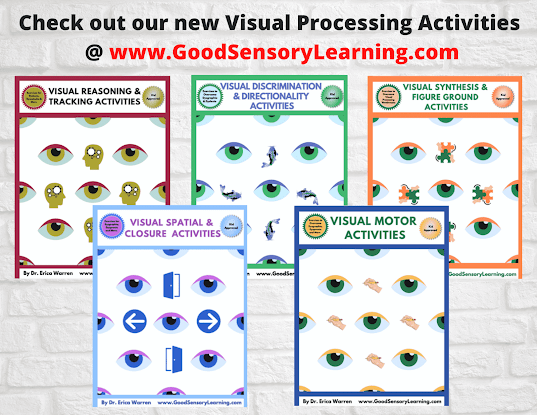This week I wanted to tell you about my online store, Good Sensory Learning. I’m Dr. Erica Warren, and I established this site so I could share all the materials that I have created over the last 20+ years as a learning specialist and educational therapist. When I first began my private practice, Learning to Learn, I had great difficulty finding fun and multisensory materials for my students that were effective and engaging. So back in 2005, I made it my mission to design and distribute high-end, remedial products as well as memorable, motivating lessons that bring delight to learning. If you would like to try a free sampling of my activities , CLICK HERE . How Are the Products Organized at Good Sensory Learning? You can download my Free Printable Catalog or you can browse the site using the grey “search all products” bar in the top right of any page with keywords such as dyslexia, working memory, and executive functioning. What’s more, drop down menus in the red banner allow you t...
Tracking is the ability to move one's eyes smoothly across the page from one word to another as well as from one line of text to another. For some learners, however, this is a challenging task. Instead, their eyes jump back and forth and struggle to stay on a single line of text. This can result in problems such as word omissions, reversals, eye fatigue, losing one's place while reading, and most importantly it can undermine reading comprehension.
Can Tracking be Improved?
Yes, one can improve tracking by strengthening eye muscles and getting one's eyes and brain to work together. There are three types of eye movements that need to be addressed:
- Fixations: The ability to hold one's eyes steady without moving off a target.
- Saccades: The ability to jump to new targets that randomly disappear and reappear in a different location.
- Pursuits: The ability to follow a moving target with one's eyes.
12 Free Ways to Improve Tracking:
- Use color overlays. Colored overlays are clear plastic bookmarks that allow students to change the background color of the text. This can make the contrast of black text on white paper less intense, and many kids find the colors soothing. Most importantly, by placing the line of text that is being read at the bottom of the plastic lens, it can be a great way for students to maintain their place while reading. To learn how to make your own color overlays, CLICK HERE.
- Play ping pong - and watch others play the game. Sit on the side of the table and keep your head steady. Watch the ball, moving your eyes back and forth across the table.
- Get a book but only read the first word and the last word in each line. Continue down the page. Time yourself and try to beat your speed. If reading words is slow or labored, just read the first and last letter on each line.
- Go to the site Eye Can Learn and do their eye-tracking exercises.
- Watch a metronome
or crystal pendulum. Place the metronome or pendulum about 2 feet from your face, keep your head steady and move your eyes with the swinging metronome or pendulum.
- Use a laser pointer on a wall and watch the red dot while moving it back and forth across the wall: go up, down, left, right, and diagonally. This will strengthen your eye muscles.
- Use Apps like Voice Dream Reader which highlights the words while it reads the text. You can read along with the synthesized voice options, or if you prefer, read the text yourself and turn off the audio. Adjust the speed so that words are highlighted while you read. This can help the brain read in a fluid manner. This app also has an option called Pacman mode where the words disappear as they are read. This forces the brain to read in a fluid manner.
- Pick a common letter of the alphabet such as the letter "A" or a common word such as "the." Select a book, or article and scan through the lines of text as if you are reading, circling the letter or word every time you see it.
- Read aloud. This helps the eyes and brain to work together.
- Play an internet version of Pong. I like Garfield Tabby Tennis.
- Practice echo reading. This is when someone reads a line of text aloud and then you read it back to them. This improves sight word recognition and fluid tracking.
- Use an index card or even a finger to help your eyes track across each line of text.
Yes, check out the Reversing Reversals series to develop tracking as well as other important visual processing and cognitive skills that will improve the foundation abilities needed to be an excellent reader.
Cheers, Erica
Dr. Erica Warren is the author, illustrator, and publisher of multisensory educational materials at Good Sensory Learning and Dyslexia Materials. She is also the director of Learning to Learn and Learning Specialist Courses.
· Blog: https://learningspecialistmaterials.blogspot.com/
· YouTube Channel: https://www.youtube.com/user/warrenerica1
· Podcast: https://godyslexia.com/
· Store: http://www.Goodsensorylearning.com/ & www.dyslexiamaterials.com
· Courses: http://www.learningspecialistcourses.com/
· Newsletter Sign-up: https://app.convertkit.com/landing_pages/69400
Dr. Erica Warren is the author, illustrator, and publisher of multisensory educational materials at Good Sensory Learning and Dyslexia Materials. She is also the director of Learning to Learn and Learning Specialist Courses.
· Blog: https://learningspecialistmaterials.blogspot.com/
· YouTube Channel: https://www.youtube.com/user/warrenerica1
· Podcast: https://godyslexia.com/
· Store: http://www.Goodsensorylearning.com/ & www.dyslexiamaterials.com
· Courses: http://www.learningspecialistcourses.com/
· Newsletter Sign-up: https://app.convertkit.com/landing_pages/69400




Comments
Post a Comment